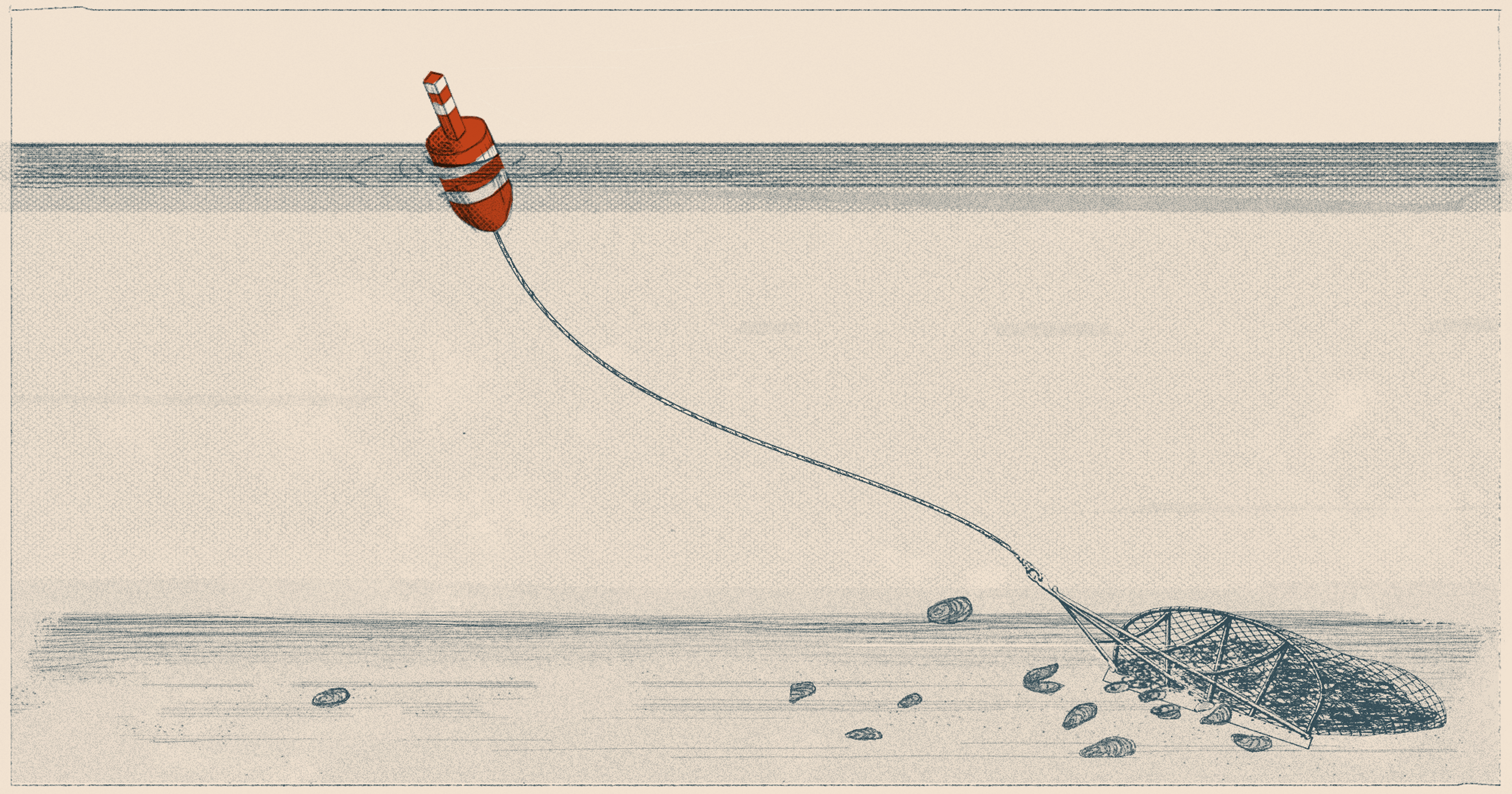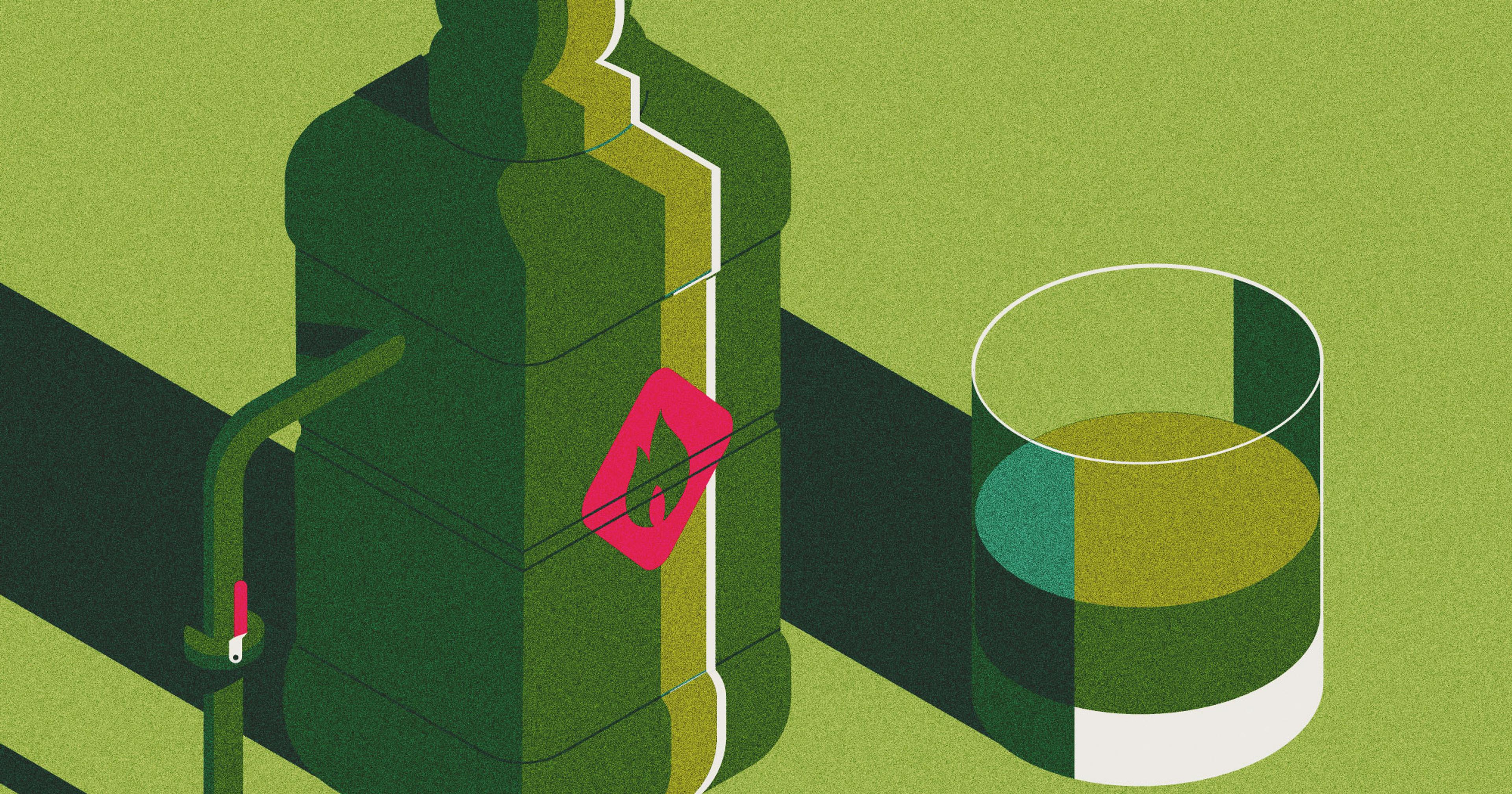Climate change and an unstable decade has left Maine’s lobstermen fearing a fishery collapse. Looking closer at ocean streams offers a healthier outlook.
Damian Brady spends a lot of his time in lobster boats, scooping up, counting, and measuring baby lobsters in the Gulf of Maine. Along with counts from scuba dives and fishing hauls, Brady’s data goes into the comprehensive Gulf of Maine Ocean Observing System that helps managers regulate the fishery. Brady also looks at “lobster settlement” — under what water conditions do these baby lobsters decide to settle in? He has studied decades of lobster booms and busts, refining the models in search of a “crystal ball,” as he calls it, on lobster futures.
“It’s in everyone’s mind that [the Maine lobster industry] peaked in 2016, and the future is a little bit in doubt,” Brady said.
Climate change has course-adjusted the Gulf Stream northward, warming the waters of southern New England, and driving a northward movement of lobster populations. It feels like history repeating: Science suggests warming waters caused the Rhode Island lobster industry to collapse earlier, going from 22 million pounds in 1997 to just over 3 million pounds in 2013.
But in Maine, lobsters are still a vital industry. On a good year, 100 million pounds of lobster may cross the state’s docks, bringing in more than $400 million. Maine’s boon from the northward lobster migration was a record-breaking lobster haul in 2016. But then lobster counts began to decline consistently, year after year into 2023. The fishery’s worst fear echoed across the docks: A Rhode Island-style collapse was heading toward Maine.
But Brady, after years of careful study, is not seeing that future. What many announced as the beginning of the end, he calls a “regime shift.”
The shift drove a downsize in the Maine lobster fleet, particularly from southern Maine towns such as Portland.
“The center of lobstering has moved [north], from the center of Maine to Downeast Maine,” Brady said.
Above Portland on a map, “Downeast” is where Maine juts into the Atlantic Ocean by way of many small islands. There, the island fishing town of Stonington brings in the largest lobster catches. Its boats are able to reach the deep, federal-permit waters far offshore where lobsters are now settling.
“There was a particular boom in deep water settlement,” Brady said, reporting the most recent surveys, “places we haven’t really looked before, or looked at much.” To scientists, new habitats call for more data.
A New View of the Ecosystem
The ‘23-’24 count of baby lobsters was up from the year prior. And early numbers from this summer promise another strong showing for ‘24-’25. Brady suspects the alarming post-2016 decline cycle is turning.
“The key is that the sky isn’t falling for the industry,” Brady said. “What you call the eastern current that’s going to be cold for a while — that’s going to allow the species to be pretty robust.”
Brady looks at the fishery in 8-year spans, the time it takes a Maine lobster to mature, and his models look even farther out, sometimes into 2050. But a fisher has to budget things like gear, bait, and fuel according to prices for a given year. Lobstermen have heard about the positive trend in stock numbers. More importantly, they’re seeing an increase in younger lobsters in their traps. From their view, it’s not a time for stepping up conservation measures.
“The regulations don’t seem to be connected to what’s actually happening now,” said Kyle Kennedy, a self-employed lobsterman in Milbridge, Maine. “They’ll change the rules based on patterns from a few years ago, without a good understanding of what we’re seeing every day.”
As regulators work to protect those lobsters through maturity, a disparity of viewpoints can lead to clashes between regulators’ better-safe-than-sorry mindset and fishers’ strike-while-the-iron’s-hot instincts.
“The key is that the sky isn’t falling for the industry.”
Brady’s most recent work is in mapping ocean currents, a relatively new enterprise for predicting lobster futures. For those watching fisheries collapse to the south, this work offers hope because in Maine, the picture isn’t as simple as warm waters driving lobsters northward. Canada’s Labrador and Scotian currents are also coming down to meet lobsters in the Gulf of Maine.
Because the laws of hydrodynamics can inform mathematical models, scientists like Brady have begun to develop models that track all these water flows entering and intermingling in the Maine lobster’s world. The Gulf of Maine has a unique underwater topography that includes basins, plateaus, and a continental shelf break, making water flows a complex system of ”eddies“ and ”blockages” scientists are only beginning to understand.
In a paper just released in Continental Shelf Research, Brady and his research team began to look closely at the mysterious, under-studied Scotian shelf stream. Meanwhile, lobsters are already navigating the changing seascape by instinct. They are picky about their water temperature. The baby lobsters Brady hunts want 12-20℃ (53.6–68° F) before they’ll settle into a neighborhood.
Vulnerable lobster larvae also need to drift into opportune ocean pockets dense with food. “The one thing that I worry about,” Maine lobsterman Bruce Fernald wrote in a public comment to the Atlantic States Marine Fisheries Commission (ASMFC), “is food for the lobster larvae when they’re on the surface.”
Maine may be unique among New England states in providing this advantage going forward. Brady points out that because Canadian streams, particularly the Labrador current, are churned up from the ocean depths, they can be full of nutrients that feed lobsters and their prey. So models that could understand how and where these pockets might occur would offer a valuable tool for predicting lobster “sweet spots.”
“The strength of that thing, that coastal continental shelf jet, means everything to what the future of this industry is,” Brady said. “And frankly we need more monitoring in there.”
From Research to Management
Brady has, in fact, been working through channels aggressively to bring monitoring buoys to the Gulf of Maine.
“We’re pushing for a new ocean observing system. There’s $5 million in the current Senate appropriations bill,“ Brady said.
Maine’s Department of Marine Resources (DMR) submitted a letter in support of federal funding for increased monitoring, to augment the Gulf of Maine Ocean Observing System.
“Improvements to this system are vital for our understanding of the impact of a rapidly changing Gulf of Maine ecosystem on the fisheries,” Maine DMR Commissioner Patrick Keliher said, adding that fisheries “are so important to our state’s economy. It will also ensure our ability to predict and prepare for the effects of a changing climate on our coastline and coastal communities.”
Basically, the monitoring buoys tick off issues near and dear to the federal infrastructure bill: They improve existing infrastructure, address climate change, and help the economy.
“I throw back several hundred pounds of under-sized lobster a day.”
According to Caitlin Starks, senior fishery management plan coordinator at the regulatory body ASMFC, the commission would be happy to consider the environmental data (as distinguished from population data) these buoys provide to support regulation —when they have it.
“But so far we don’t have a lot of data available.“
Meanwhile, regulators have to take measures (“Use levers and knobs,” as Brady puts it) to ensure that both the fishing industry and the lobsters thrive sustainably. And the science of counting has its limitations.
By 2023, stock assessments had confirmed that the average of three years of lobster counts had declined 39% over the 2016-2018 average. It was such a dramatic decline, it unexpectedly triggered an ASFMC regulation to increase the “gauge size” — smaller lobsters would no longer be viable catches.
“I throw back several hundred pounds of under-sized lobster a day,” said Maine lobsterman Dustin Leighton.
The unexpected gauge increase caused immense push back from lobster fishers already nervous about the future of their industry. Leighton and other lobstermen sent public comments to ASFMC. They’ve been facing increased regulation on many fronts, much of it arguably climate-related.
“I have never seen them admit a mistake or reverse a regulation. We just have to live with it.”
“The industry continues to support robust science,” Patrice McCarron, acting COO at the Maine Lobstermen’s Association said, “to understand the health of the resource and ensure that any future regulations are based on accurate data.”
On the gauge increase, fishers questioned the science. An 8-year study of averages wasn’t matching up with the lobster numbers harvesters were seeing in their traps. They felt they might become a casualty of over-caution. Additionally, they fear the stricter regulations are here to stay.
“I have never seen them admit a mistake or reverse a regulation,” said Kennedy, a 16-year industry veteran. “We just have to live with it.”
Lobstermen often feel that their real-world connection with the resource gives them an expertise that regulators may be missing. “We are your best and largest data source,” lobsterman Eric Smith wrote in his public comment. “Thousands of sets of eyes on the resource and taking part in catch reporting programs.”
Lobstermen’s groups took the issue to Maine congressman Jared Golden (D-Lewiston), who drafted a bill to oppose the increased gauge size issuing a call for “more accurate lobster stock data.”
“I am concerned,” the congressman told ASMFC in his public comment about the size increase, “that the data used to arrive at the trigger index for a gauge increase is overly precautionary.”
This push-back against strategies based on stock assessments underscores the need for new types of data. For Starks at the Atlantic States Commission, environmental data provided by monitoring buoys can only help strengthen the case for regulatory measures.
“I think that certainty is the bigger issue,” she said. “We could come up with other levers and knobs, but even those might not be certain, as far as impact on the population.”
The gauge size increase, delayed to January, is likely to be pushed back again, at least to July 2025. And perhaps lobster populations, which do seem to be increasing, have dodged a bullet this time. As with so many other climate-related changes, the balance between resource use and sustainability demands increasingly precise assessments of risk.
As Brady put it, “There’s only so many triggers you can afford to avoid.”










